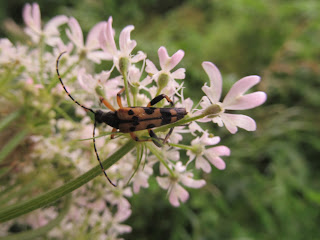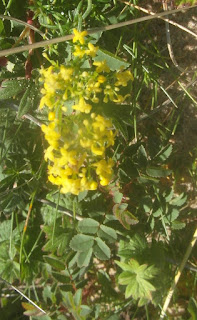Some very impressive results from trials of a Canadian vaccine trialled in Guinea where the material seemed to offer 100% protection (http://www.bbc.co.uk/news/health-33733711). It has been suggested by the WHO that this might be a 'game changer', preventing further catastrophic outbreaks of the disease in Africa. It shows what can be done when modern technology is applied to conditions more important than male hair loss.
This blog may help people explore some of the 'hidden' issues involved in certain media treatments of environmental and scientific issues. Using personal digital images, it's also intended to emphasise seasonal (and other) changes in natural history of the Swansea (South Wales) area. The material should help participants in field-based modules and people generally interested in the natural world. The views are wholly those of the author.
Friday, 31 July 2015
Ebola back in the bottle?
Some very impressive results from trials of a Canadian vaccine trialled in Guinea where the material seemed to offer 100% protection (http://www.bbc.co.uk/news/health-33733711). It has been suggested by the WHO that this might be a 'game changer', preventing further catastrophic outbreaks of the disease in Africa. It shows what can be done when modern technology is applied to conditions more important than male hair loss.
No Flies on Rob
Some flies are quite interesting. There is a report that one such beast, Rhaphium pectinatum, last recorded in Richmond, Surrey in 1868 and thought to be extinct, has been found by a fly enthusiast called Rob Wolton in the Devon Wildlife Trust's Old Sludge Beds Nature Reserve (http://www.theguardian.com/uk-news/2015/jul/31/first-sighting-for-150-years-of-fly-thought-to-be-extinct). Congratulations to the fly for staying under the radar for such a long period and congratulations to Rob for being able to recognise it!
Wednesday, 29 July 2015
Down in the Mouth
Lots of media ire re a Minnesota dentist who reportedly paid thousands of dollars to kill a lion with a bow and arrow in Zimbabwe (http://www.theguardian.com/world/2015/jul/28/walter-palmer-dentist-accused-killing-cecil-lion-upset-hunter-zimbabwe). It turns out that the lion was 'famous' being part of a long-term study and had a collar facilitating satellite tracking. The animal (it may well have been used to humans) was reportedly enticed outside a protective park so it could be shot. The dentist blames his guides for misleading him but a) American dentists don't need to kill lions with the profits extracted from people's teeth, b) He was presumably much richer than his 2 guides, so one could say he enticed them and c) What kind of an eagle-eyed hunter fails to see a collar around the animal's neck? I personally think that this whole trophy ideology needs fixing!
Sunday, 26 July 2015
Seeing the Changes 992
Spent one of this Summer's few fine days at Oxwich and couldn't help being struck by the effects of climate. I saw a morel-like fungus and a large toadstool on the dunes (it's high summer!). Some of the usual plants were in flower including Eyebright (Euphrasia officinalis); Wood sage (Teucrium scorodonia); White stonecrop (Sedum album) and the end of the Kidney vetch (Anthyllis vulneraria) and Yellow rattle (Rhinanthus minor) seasons. There was also less Wild thyme (Thymus serpylium) than usual. The usual range of day-flying Lepidoptera was also not in evidence but the Small skipper (Thymelicus flavus); Small blue (Cupido minimus); Six-spot burnet moth (Zygaena filipendulae); Grayling (Hipparchia semele); Callistega mi and Small heath (Coenonympha pamphilus) were spotted in reduced numbers. Hardly any beetles were seen but a solitary wasp optimistically explored.
Friday, 24 July 2015
It's a Wild Animal, For Goodness Sake!
There seems to be an incredible media frenzy about 'cold-eyed, killer' Herring gulls killing tortoises, small dogs, swallowing 'mother' starlings whole, pecking people and ripping pasties out of our hands (http://www.theguardian.com/environment/2015/jul/23/killer-seagulls-top-the-pecking-order-for-a-media-frenzy). The birds have even been likened to terrorists and there have been yet more calls to 'cull' them (who's the terrorist then?). This medium-sized bird is a wild species that is designed to obtain food for itself and its chicks. All the examples cited could easily reflect the animal being a) offered a tempting meal or b) protecting its eggs and chicks from possible predators. Humans (by inappropriate waste disposal and becoming associated with food rewards when snacking outside) and providing high buildings as cliff substitutes for nesting have been a major factor in increasing their numbers and concentrating them in towns and cities (the name 'seagull' is a bit of a misnomer).
Watching the Bees and Qs
The NFU have apparently negotiated an 'emergency' relaxing on the ban of neonicotinoid pesticides that have been linked to changes in the behaviour and survivorship of bees and other pollinators (http://www.theguardian.com/environment/2015/jul/23/uk-suspends-ban-pesticides-linked-serious-harm-bees). The ban is said to have been removed so that rape seed oil growers can treat their crop to kill off cabbage stem flea beetle which can damage the monoculture. I am not sure that such 'temporary' relaxations are either warranted or desirable. Certainly, even farmers can't do without their pollinators.
Tuesday, 21 July 2015
Monday, 20 July 2015
Seeing the Changes 989
Lots of stuff about in Llangennith near the surf. In bloom, was Lady's bedstraw (Gallium verum); Ses spurge (Euphorbia paralias); Sea bindweed (Calystegia soldanella); Sea holly (Eryngium martimum); Sea stock (Matthiola sinuata); Rest harrow (Ononis repens); Pyramidal orchid (Anacamptis pyramidalis); Stone bramble (Rubus saxatilis) and Bloody cranesbill (Geranium sanguineum). There were also lots of jellyfish on the shore and, on umbellifers, the Cteniopus sulphureus and Rhagonycha fulva beetles danced.
Friday, 17 July 2015
Frack the SSSIs!
There is some anger that the UK government is apparently going back on its promise not to allow fracking on Sites of Special Scientific Interest (SSSIs) if it gets in the way of developing a fracking industry (http://www.theguardian.com/environment/2015/jul/16/government-makes-outrageous-u-turn-over-fracking-in-precious-wildlife-sites). They suggest that safeguards can protect these areas but many are very small and any drilling could completely negate their role.
Giving Wings to Fancy?
A new fossil of a dinosaur from China apparently had wings and feathers but would (because of its size and weight) have been incapable of flight (http://www.bbc.co.uk/news/science-environment-33510288). There are apparently two possibilities. The first is that the species (like birds such as the penguin and the ostrich) lost the power of flight. The other is that wings in these reptiles were not initially designed for flying but (like the peacock's tail) were part of sexual display. It seems likely that only further fossil evidence solve this conundrum.
Sweet!
There is currently a lot of debate about the problems (obesity, tooth decay, type 2 diabetes, diabetes-linked amputations etc) associated with the British obsession for sugar with a claim that no more than 5% of daily calories should come from this source (http://www.theguardian.com/society/2015/jul/17/cut-recommended-daily-allowance-sugar-5-percent-daily-calories-report). The medical profession have even suggested imposing a tax on sugar-laced drinks and using the raised money to reduce the costs of healthier options. Food manufacturers are not notably keen and appear to suggest that anyone can choose healthier options by reading lists of ingredients on packaging. I don't think is is really all that easy and some groups (children, visually impaired and the working poor) are likely to find this problematic. I don't get the impression that the government will do much that might irritate the sugar crew!
Fluttering Into Action!
The Big Butterfly Count for the UK (http://www.theguardian.com/uk-news/gallery/2015/jul/17/the-big-butterfly-count-2015-in-pictures) is springing into action with a prediction that the Small tortoiseshell (Aglais urticae) will be making a big recovery (although I did think their 'unexplained' decline had been linked to an infection). I have certainly seen this species this year but 2015 has not been a good one here in terms of species diversity or numbers
Wednesday, 15 July 2015
Monday, 13 July 2015
Making a Hole Lot of Improvements?
The RSPB is undertaking a huge development at Wallasea in Essex where they are using much of the 'spoil' from the Crossrail borings to increase the height of the island (http://www.theguardian.com/environment/2012/sep/17/crossrail-earth-wetland-nature-reserve). This will enable them to construct a system of lagoons that, it is hoped, will attract in substantial numbers of wading birds including Spoonbills. This seems an innovative use of 'waste'. It's certainly better than just creating a mound of soil and clay.
Saturday, 11 July 2015
Subscribe to:
Comments (Atom)
-
I n the UK and US, a pparently popular and successful vegan/vegetarian restaurants are reportedly closing or adding meat to their menus ( ...
-
Early ripening fruit may seem convenient but some folk think it confirms environmental stress. There's also a possibility th...





















































%20mating%20NWCW.jpg)

